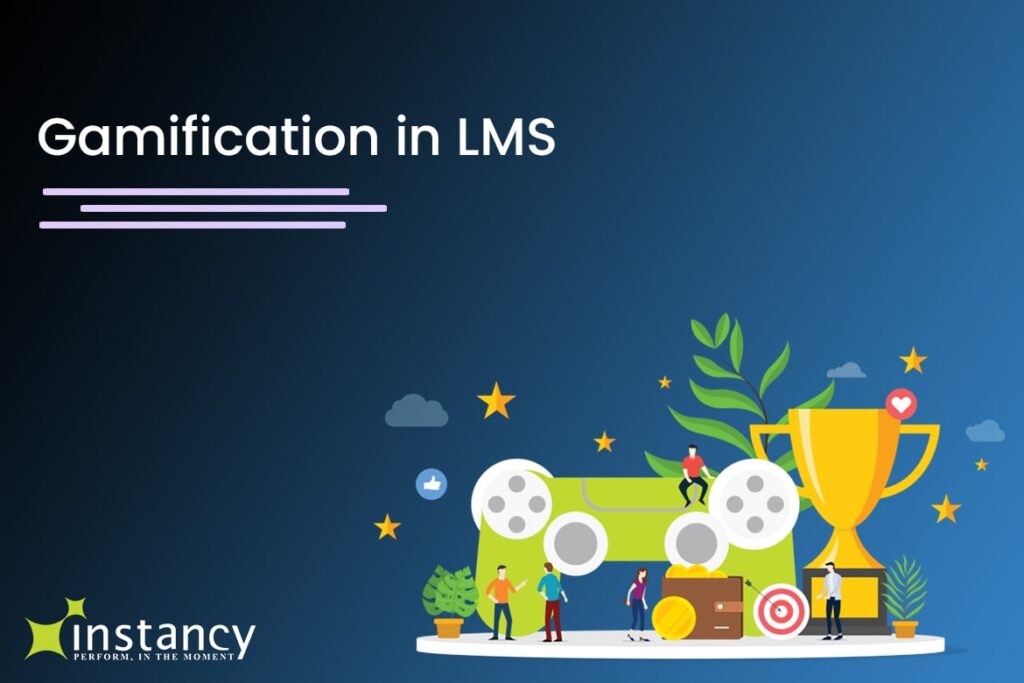Gamification in a Learning Management System (LMS) and eLearning Environment has got Many Exiting things with learning promotion.

Overview Gamification of the learning online environment has caught on tremendously today with exciting game-like interfaces, interactions, quizzes and much more to facilitate and promote learning. Rewards and recognition in these learning games help motivate the learners to participate and complete the learning program. Gamification can be applied to course content and the learning environment, as required. This article will focus on gamification at the learning environment (or the learning management system).
Gamification Learning Management System in eLearning Environment
What is Gamification? Gamification is defined as the basic application of gaming mechanics to non-gaming scenarios. The use of game mechanics, dynamics, and frameworks to promote desired behaviors is used in domains like education, marketing, politics, healthcare and much more. Analysts foresee it becoming a multi-billion dollar industry by 2015 (MacMillan, 2011). Components of Gamification Gamification elements are usually defined around the areas of teamwork, collaboration, and competition. Simple “scoring” and ranking techniques like badges are used in most courses today. Other gamification techniques may include reminders via email or mobile learning apps that connect the users back to the learning system. Research shows that a learner, after having drifted away from a learning program, may be motivated to rejoin the program after seeing a notification about how their peers are doing in the program. A learning system that connects with social platforms used by learners, such as Facebook or Twitter, is popular among today’s learners. Some of the main components of gamification are explained below. A Well-defined Learning Objective Having an objective is very important for an adult learner. Gamification should help a learner reach his or her objective. Games that do not help a learner achieve a goal or reinforce learning are ineffective and demotivating. Points Points are used in gamification to a great extent. Points can be accumulated in exchange for gifts or other rewards. A mechanism that assigns points each time a user performs an action within an LMS is a great idea to keep learners involved. Levels Multiple levels may be assigned to the learners based on their progress and achievement after completing certain activities Timer Gamification may also include a timer function on certain activities. The timer function motivates learners to complete the assignment by a certain deadline. Progress Bar A progress bar helps learners know where they are and how far they still have to go. Learners will be driven to take steps to 100% completion when a progress bar is displayed for certain actions. Leaderboards Leaderboards are one of the major features of games. Leaderboards are defined on the Gamification Wiki as “a means by which users can track their performance subjective to others. Leaderboards visually display where a user stands in regards to other users. They are implemented on sites to show which players have unlocked the most achievements. The desire to appear on the Leaderboards drives players to earn more achievements, in turn fueling deep engagement.” Leaderboards drive performance and give learners a strong sense of community. Rewards, Badges and Certificates Motivational tools like rewards, badges and certificates keep a learner interested and engaged. Learners are, therefore, encouraged to do better in exchange for rewards and badges as proof of their success. Having a real-world reward helps translate virtual success into real-world value for learners. A scoring system that is linked to the actual participation in an E-Learning program will help learners get a competitive spirit. A badge for E-Learning can be directly connected to a point system. Recognition and Acknowledgement Learners may be recognized for their accomplishments or contribution within the learning environment. This recognition may be automated by the system, for example, the learners’ names and pictures may be featured on the learning portal or website. In addition, recognition from peers and experts within a community may be even more motivating for most individuals. Social Social connectivity is a powerful engagement tool in today’s times. Introducing social networking as part of gamification in an LMS is a great way of keeping learners engaged. Gamification elements that take advantage of social networking include sharing scores, badges, and statuses to the major social platforms. Social networks can be used to recommend content and even entire courses to co-workers and peers; post reviews of courses, and host discussions about course content in the form of comments as well as directed questions.
Gamification in a Learning Management System (LMS)
When learners first log in to their LMS, they may not have any idea about gamification and how gamification features work. As they gain more familiarity with the LMS user interface, they begin to get more skilled, engaged and educated about the gamification features. Initially, many learners may not go beyond the ‘Novice’ level due to lack of interest in the LMS or content with found within the LMS. Getting such learners engaged with the LMS, learning process and content through gamification will surely help them become masters!
The process of gamification in an LMS includes:
- The learner logs into the LMS and sees a message explaining the benefits of the learning programs. Learners are asked several questions and then understand how ‘gamified’ eLearning will help them
- Learners are given a tour of the LMS and its gamification features
- The LMS tracks all learner activities like login details, profile edits, social activity, formal learning, contributions, participation in discussion forums and so on. Learners are given a chance to earn more rewards or points while learning online. For example, changing the profile picture may give points. New eLearning technical standards and protocols like Experience API (xAPI) can be successfully used to track various learner activities at the LMS and course levels and can help implement gamification features
- A progress bar encourages learners to view their current status and helps them move toward completing a particular level to earn additional badges
- Rewards, points, badges or certificates are awarded as per the activities or lessons completed and may be displayed through visually exciting ways within the LMS interface
- Email notifications and mobile push notifications may be used inform users about their progress and invite them to participate in the learning activities
- Gamification encourages competition and cooperation amongst learners. Rewarding learners for their contribution, achievements and participation is truly motivational and engaging to them.
Summary
Many studies in gamification have shown that the mechanism of a game increases the involvement of users while stimulating their active attendance. Having participants actively involved, and not mere passive recipients of content, is one of the most important challenges of conventional learning modes. Inadequate engagement of the learners with the learning management system has resulted in dropouts, failures, and lesser interest of learners in the learning program. Gamification has proved to increase engagement and motivate a learner to do far better. What’s more, it enhances qualities such as diligence, originality, and resilience. However, gamification can only provide tools, and those tools must produce results that are worth the investment. The process of gamification in learning must give students comprehensible and actionable tasks with immediate rewards instead of vague and unclear long-term benefits.





